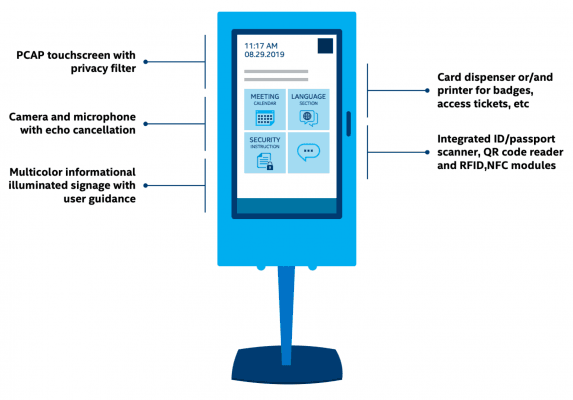Interactive Kiosks Transform Visitor Management

From grocery store checkouts to fast-food ordering, the world is increasingly embracing self-service. One study found that 75 percent of customers find self-service options to be convenient, and 67 percent would rather serve themselves than speak to a company representative.
Businesses benefit, too. Self-service kiosks improve operations in a variety of ways, including tracking visitors, collecting data, lowering overhead, and improving customer service.
While interactive kiosks have been around for more than 40 years, the technology has evolved, enhancing their use cases. Today they are game changers in enterprise organizations, automating and streamlining important tasks.
Case Study: Digitizing Visitor Management
A self-service kiosk solution recently helped an international filter manufacturer improve its visitor management process. The Switzerland-based company needed a way to register guests at its facilities and conduct necessary safety procedures. Its paper-based system had significant pain points.
First was the growing need for documentation. The manufacturer had locations in 10 countries, and the printed safety information it provided guests presented the potential for a language barrier. And its registration process wasn’t linked to an automated IT system for the data collection and tracking needed for Good Manufacturing Practices—regulations that set standards for manufacturers. Instead, the company had to rely on human data entry, which introduced the risk of error.
In addition, the IT department was tasked with handling visitor management, putting a strain on its resources. Instead of spending their time on important technology-focused work, IT staff members were sending and managing visitor invitations as well as fielding support calls from employees and guests.
To address these challenges, the company chose the eReceptionist solution by friendlyway, a maker of customized self-service kiosks for a variety of industries. Interactive displays like the one shown in Figure 1 “greet” visitors, enabling them to easily check in, print credentials, and learn safety requirements.

Fully Automated Interactive Kiosks
eReceptionist digitizes and automates the visitor management process. Employees can invite guests through a web console that generates and sends QR codes via email. When visitors arrive on-site, a digital display guides them through the check-in process, from scanning their code to accepting safety instructions. If identification authentication is needed, a built-in scanner reviews and approves visitor documents such as passports and driver’s licenses.
“Self-serve kiosks should improve the customer experience since the process is standardized, everyone gets the same treatment, guaranteed.”
“The convenience of the end-user has to be balanced with the need for information of the business,” said Dr. Swen Osterkamp, chief product officer for friendlyway.
The solution offers a set of pre-configured, customizable software modules that can be combined to cover the key needs for visitor management. These solution-ready modules can be more quickly deployed while offering a meaningful, consistent solution. In addition to guest check-in, the digital displays can be used for signage, welcome messages, wayfinding, and meeting information.
The software modules run on the embedded Intel® NUC, a small form-factor PC running Windows 10. Kiosk models come in various display designs with functionality to fit different needs, depending on the complexity of the solution required and the environmental conditions. The hardware includes a touch screen, QR code reader, phone, and camera (Figure 2).

“The user flow screens are personalized with wording and logotypes and other corporate-style elements,” added Osterkamp. “A ticker can be provided with corporate messaging or screensaver videos. Also the kiosk can be branded individually with foiling.”
The system is easily updated, which future-proofs the process. friendlyway hosts the solution, offering it as a software-as-a-service (SaaS) solution.
Improving Operational Efficiencies
After installing the eReceptionist system, one of the most notable improvements the manufacturer experienced was transparency. The solution makes the visitor management process digitized and traceable. For example, visitors must confirm that they’ve read safety instructions.
“The need for transparency comes from external sources and internal demands,” said Osterkamp. “Security companies and other regulators impose rules on companies for safety. Good Manufacturing Practices are increasingly becoming an obligation.”
Administrators also get real-time data and analytics about visitors that provide insights about who’s going in and out of facilities. Because the solution is cloud-based, they can monitor all of the kiosks from a desktop PC or mobile device.
Self-service kiosks also maximize enterprise resources. The IT staff is free from time-consuming support tasks, and can focus on value-generating projects. And visitors are more satisfied with the quick, self-explanatory check-in process.
“Digitizing all information makes sure to have a repeatable process,” said Osterkamp. “There is no island of paper-based information, which is not integrated with the rest of the enterprise. There is a potential for cost saving, especially when rolling out to multiple sites. And in the future, kiosks can be enhanced with AI-based features like face recognition.”
As more businesses turn to self-serve kiosks, Osterkamp recommends that customers look for complete, integrated systems. The partnership with Intel® allows friendlyway to bring end-to-end solutions to market.
“This is where we distinguish ourselves from a lot of vendors,” he said. “Some are good at hardware manufacturing and others have software capabilities. You want a solution that’s comprehensive, with everything from a single source.”
While self-serve kiosks have benefits for companies, it’s ultimately their visitors who must use them.
“Self-serve kiosks should improve the customer experience,” said Osterkamp. “Since the process is standardized, everyone gets the same treatment, guaranteed.”